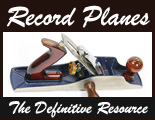Perfect Pitch – Bedding Angles Explained
It’s no secret to anybody familiar with using hand planes that different blade angles produce different results. A lower blade angle is generally better for end grain work while a very high blade angle is great for scraping. Is there a perfect blade angle that will do all manner of jobs in all circumstances? The answer, of course, is no.
Planes come with many varieties of pitch, or bed angle. Some planes have pitch as low as 10°, while others are 45°, 55°, 70° and up to 90° or more. Then you also have terminology such as “Common Pitch”, “York Pitch”, “Middle Pitch” and “Half Pitch”. What do all these terms mean? How do you know exactly what pitch you want for what job? As with everything else in life there are always exceptions to any rule but, generally speaking, there are guidelines that can be followed to help make your choice easier.
The amount of pitch affects the ease of cutting when using a hand plane. A plane with a lower pitch will cut more easily than a plane with a high pitch. The downside to this though is that a low angle is more susceptible to tearing out the wood as it cuts, leaving a rough surface. This is because the splinter ends have broken beneath the surface due to the “wedging effect” of the plane blade. For an exaggerated view of this think of the wedging and splitting action of an axe, rather than a hand plane.
The effect of this splitting can be countered, to a degree, by having a very fine mouth and preventing the wood fibers from lifting prematurely – essentially creating shorter splinters rather than longer ones. Of course when used on end grain this wedging effect is not an issue as the ends of the fibers are being sheared, rather than cut along their length. This “shearing action” can be further enhanced by skewing the blade and slicing through the fibers at an angle, rather than straight across, and some planes make use of a skewed blade to achieve this (such as the Stanley #140 block plane). Skewed blades can also be useful on rebate (rabbet) planes, though you may need both a left and right handed plane in some instances.
It should also be noted that a properly ground and set chip-breaker will help to create shorter splinters and allow the shaving to break almost immediately it is cut with the blade. It may also assist in making sure that the throat of the plane will not become blocked as easily.
Pitches and uses:
20° and under — Used for low angle planes such as mitre planes, shoulder planes and block planes. The blades for these planes are used with the bevel up, which has the effect of increasing the overall pitch by the amount of the bevel angle. As these planes are usually used for end grain work, having a lower angle with the blade supported right to the tip and a fine mouth opening is a major advantage.
45° (Common Pitch) — Used for most bench planes, from wooden bodied ones to Stanley/Bailey type. A bedding angle set at 45° is optimum for most softwoods and straight grained hardwoods and the blade is used with the bevel down, requiring a chipbreaker in most cases (especially when using a thinner blade). Japanese style planes don’t need a chipbreaker because the blades are usually quite thick.
50° (York Pitch) — Used for hardwoods and is especially useful for highly figured and interlocking grain. Also used for rebate (rabbet) planes and some grooving planes.
55° (Middle Pitch) — Mainly used for moulding planes for softwoods.
60° (Half Pitch) — Used for moulding planes for hardwood.
70° to 90° — Used for toothing planes, side snipers and side rebate (rabbet) planes.
90° plus — Scrapers and scraping planes.






